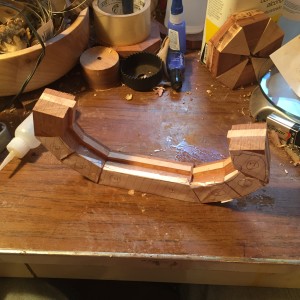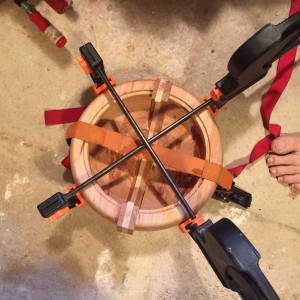1/22/2016 – Willow Bowl
I had promised someone that I would make them a bowl, after some stuff we were working on was completely done. Well, everything got concluded and I realized that I hadn’t even started on the project. Scrounging through the shop, I found a chunk of willow that had been sitting in the shop since early summer of 2013. Since that’s the same time all the craziness started, I figured I could finish turning it real quick and keep my promise.
The wood for the bowl came from a neighbor, who said it was some kind of willow tree, but not the weeping kind. The he went on to tell me just how terrible this tree had been, how it was basically an overgrown weed, and that the happiest day of his life since moving into the house was having it cut down. All I heard was “free, if you want it”. I remember two things from when I was roughing out the bowl. First, it was some of the wettest wood I’ve ever seen. The moisture meter said 55% and as the freshly cut wood spun, it flung water up the wall, across the ceiling, and across the face shield I was wearing. I had to stop turning every couple of minutes and wipe the shield off so I could see. My smock got wet, my tools got wet, and my patience ran out pretty quickly. Second, the wood had this weird green tint to it. Not enough to look like it had been dyed, but just enough to make it look, well, ugly. My hopes were not high that this free wood was going to be worth the effort it had taken to haul it home.
Time passed and the blank dried. When I put the moisture meter on it and it was at a safe 10%, I figured it was ready to use. There were no noticeable cracks, but it had warped fairly bad. It also had this grimy look on the outside of the bowl, like it had started to rust or had been drug through a whole bunch of dust. My hopes went even lower.
When I started shaping the outside of the bowl, I didn’t really stop to look at the wood, I figured I’d finish shaping the outside of the bowl and then see just how bad things looked. If it was too bad, I could always burn it. When the lathe finally spun down, I was absolutely shocked at what I was looking at. Under the coating of whatever that skeezy stuff was caked to the outside, there was a very pretty blonde color, there was some interesting things happening with the grain pattens, and there was this funky brown streak that was coming out in places. it actually looked pretty cool!
By the time I got the inside of the bowl done and the base of the bowl finished, I was starting to have second thoughts about giving this one away. After it was sanded down to 600 grit, I put on three coats of lacquer, then buffed it and added a coating of carnuba wax. May not be able to see it in the picture, but it feels like glass like and shines in the light.
I ended up giving the bowl away, because after I considered everything this woman had done for my family, this small token of appreciation may still not be enough. Here’s a couple pictures, just to see what I’m talking about:







